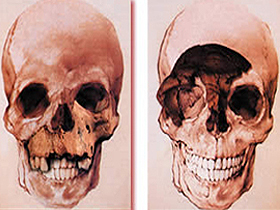In 1995, three Spanish paleontologists from the University of Madrid found a fossil in the Gran Dolina cave in Spain’s Atapuerca region. It was a section of the facial bones of an 11 year-old child that is identical to human children living today. But the child died 800,000 years ago! This was a surprising discovery for evolutionists, who did not hope that Homo sapiens (modern-day human beings) lived so long ago. (See Imaginary Human Family Tree, the.)
The December 1996 issue of Discovery magazine gave it wide coverage. This fossil even shook the convictions about evolution of the head of the Gran Dolina research team, Arsuaga Ferreras, who said:
We expected something big, something large, something inflated—you know, something primitive. Our expectation of an 800,000-year-old boy was something like Turkana Boy. And what we found was a totally modern face. . . To me this is most spectacular—these are the kinds of things that shake you. Finding something totally unexpected like that. Not finding fossils; finding fossils is unexpected too, and it’s okay. But the most spectacular thing is finding something you thought belonged to the present, in the past. It’s like finding something like—like a tape recorder in Gran Dolina. That would be very surprising. We don’t expect cassettes and tape recorders in the Lower Pleistocene. Finding a modern face 800,000 years ago—it’s the same thing. We were very surprised when we saw it.47
This fossil indicated that the history of Homo sapiens had to be pushed 800,000 years into the past. But according to the human family tree fabricated by evolutionists, H. sapiens could not have lived 800,000 years earlier. Deciding that this fossil belonged to another species, they invented an imaginary species called Homo antecessor and assigned the Atapuerca skull to it.


Facial bones discovered in Spain showed that human beings with the same facial structure as ourselves were living 800,000 years ago.
47 Robert Kunzig, “The Face of an Ancestral Child,” Discover, December 1996, pp. 97-100.


